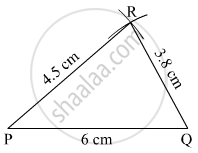Advertisements
Advertisements
Question
In ∆ PQR, l(PQ) = 6 cm, l(QR) = 3.8 cm, l(PR) = 4.5 cm
Solution
Steps of construction:
- Draw a line PQ = 6 cm.
- With P as centre and 4.5 cm as the radius, draw an arc above the line PQ.
- With Q as the center and 3.8 cm as the radius, draw an arc cutting the previous drawn arc at point R.
- Join RP and RQ.

RELATED QUESTIONS
Choose the lengths of the sides yourself and draw one equilateral, one isosceles and one scalene triangle.
Draw triangle with the measures given below.
In ∆MAT, l(MA) = 5.2 cm, m∠A = 80°, l(AT) = 6 cm
Draw triangle with the measures given below.
In ∆FUN, l(FU) = 5 cm, l(UN) = 4.6 cm, m∠U = 110°
Construct a triangle of the measures given below.
In ∆SAT, l(AT) = 6.4 cm, m ∠A = 45°, m ∠T = 105°
Construct a triangle of the measures given below.
Students should take examples of their own and practise the construction of triangles.
In ∆LMN, l(LM) = 6.2 cm, m∠LMN = 60°, l(MN) = 4 cm. Construct ∆LMN.
Construct a triangle using the given data: PQ = 4.8cm, QR = 6.3cm and PR = 5.5cm
Construct a triangle using the following data: XY + YZ = 5.6 cm, XZ = 4.5 cm and ∠X = 45°
Construct a triangle using the given data: PQ - PR = 1.5 cm, QR = 6.0 and ∠Q = 45°
